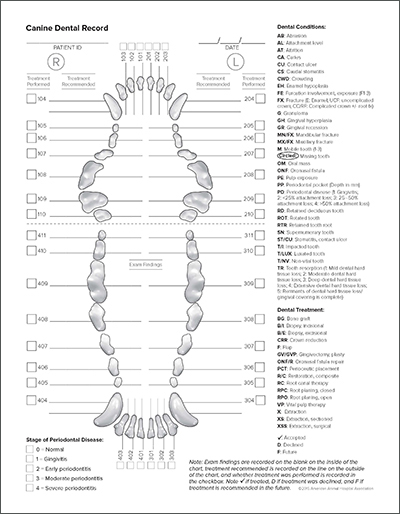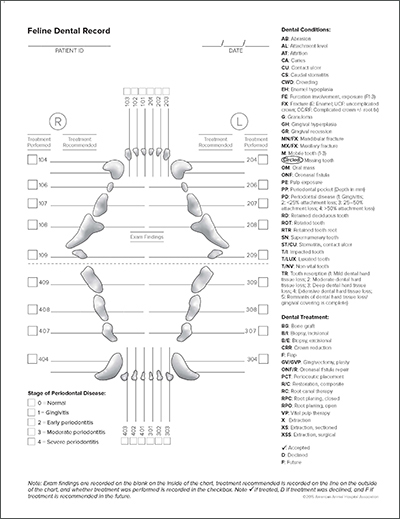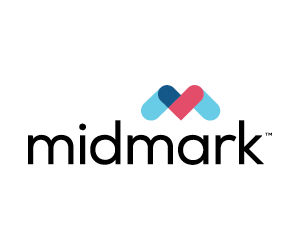Unconscious oral evaluation
Only after the patient has been anesthetized can a complete and thorough oral evaluation be successfully performed.33 The comprehensive examination includes a tooth-by-tooth visual examination, probing, mobility assessment, radiographic examination, and oral exam charting (Figure 2). Figures 3 and 4 show AAHA canine and feline dental charts that can be used to record oral health exam findings for the patient’s dental records. After collecting this objective information, an individualized treatment plan can be discussed with the pet owner. A customized treatment plan should consider not only the extent of diagnosed pathology but also the practitioner’s comfort level in performing such treatments, the client’s willingness to comply with recommended anesthetized recheck oral exams or retreatments, and the client’s willingness and ability to provide supplemental home dental care.

FIGURE 2 A “four-handed” dentistry procedure with the practitioner dictating oral exam findings to a dental assistant. Photo courtesy of Jan Bellows.
It is imperative that the practitioner recognizes that an anesthetized oral examination with intraoral radiography is necessary for complete assessment of oral health. One study found that 28% of grossly normal teeth in dogs actually had clinically important findings radiographically, and a similar study in cats reported 42% of grossly normal teeth demonstrated clinically important radiographic findings.34,35 Without intraoral radiography, the full extent of disease can easily be underestimated, leading to inappropriate treatment recommendations and failure to detect painful disease conditions. Additionally, because of the risk of overlooking retained tooth roots or causing iatrogenic jaw fracture, the American Veterinary Medical Association’s Professional Liability Insurance Trust considers it difficult to defend recommending dental procedures without appropriate client counseling and without offering intraoral dental radiography.36 If full-mouth intraoral dental radiographs cannot be taken, it is the responsibility of the healthcare team to advise the client that a complete, comprehensive examination cannot be performed.
In order to maximize patient benefits, full-mouth intraoral dental radiographs are necessary to avoidmissing inapparent pathology and to establish the patient’s baseline. At a minimum, pre- and postextraction intraoral dental radiographs are essential. Although the interpretation of full-mouth radiographs may risk overtreatment of coincidental findings, it has been well documented that more clinically relevant pathology can only be identified radiographically.34,35
As practitioners obtain the equipment necessary to take intraoral radiographs, it is essential to develop the knowledge and skills necessary to take and interpret diagnostic images. Opportunities to receive continuing education in these areas can be sought from veterinary dental specialists (Diplomate AVDC) and Veterinary Technician Specialists in Dentistry (VTS Dentistry) at national veterinary conventions, the Annual Veterinary Dental Forum, in books and online courses, and at private continuing education events.
The Guidelines Task Force strongly recommends full-mouth intraoral dental radiographs in all dental patients.









